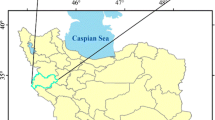Abstract
Many underground excavation failures are caused by severe water inflow due to the piping through the opening in the diaphragm wall. The opening can be created by slurry pocket or air pocket during concrete placement by tremie method. This type of defect in diaphragm wall can be detected by sonic logging to show the condition of trench wall and by measuring actual concrete dosage during placing. The same detecting method can be used in two very rare case histories where just-completed primary panels in very soft and thick clay deposit were overturned from the adjacent tremie concreting secondary panel during cold winter. The abnormal increasing concrete dosage and the smooth trench wall profile of secondary panel from sonic logging identify the occurrence of this incident. The causes to trigger this incident include (1) panel size, (2) weather condition, (3) tremie concreting speed of secondary panel, (4) initial and final setting times of concrete in trench, (5) roughness of trench wall, etc. Since the temperature for the two case histories is very low during tremie concreting, the initial setting time of concrete in secondary panel, given by equivalent age maturity function, is much longer than the time to place the concrete in secondary panel. To clarify the failure mechanism, the force-equilibrium analysis of inclined primary panel is conducted taking into account the driving force induced by the concrete pressure in the unset secondary panel and the resistant force given by the adhesion between inclined primary panel and soft clayey soil. It can be concluded from this investigation that the concrete in the secondary panel due to lower concrete curing temperature still remains unset or in plastic form and this will generate much larger driving force to push the adjacent just-completed primary panel to tilt. The measures to prevent similar incidents from happening are also suggested in this paper.
Similar content being viewed by others
References
ASTM (2011). “Standard practice for estimating concrete strength by the maturity method.” C1074,West Conshohocken, PA, DOI: 10.1520/C1074-11.
Bjerrum, L. and Simons, N. E. (1960). “Comparison of shear strength characteristics of normally consolidated clays.” Research Conference of Shear Strength of Cohesive Soils, Boulder, Colorado, American Society of Civil Engineers, pp. 711–727.
Brooks, A. G., Schindler, A. K., and Barnes, R. W. (2007). “Maturity method evaluated for various cementitious materials.” Journal of Materials in Civil Engineering, Vol. 19, No. 12, pp. 1017–1025, DOI: 10.1061/(ASCE)0899-1561(2007)19:12(1017).
Carino, N. J. and Lew, H. S. (2001). “The maturity method:From theory to application.” Proceedings of the 2001 Structures Congress & Exposition, May 21-23, 2001 Washington, D.C., American Society of Civil Engineers, Reston, Virginia, p. 19, DOI: 10.1061/40558(2001)17.
Carino, N. J. and Tank, R. C. (1992). “Maturity functions for concrete made with various cements and admixtures.” ACI Materials Journal, Vol. 89, No. 2, pp. 188–196, DOI: 10.14359/2275.
Freiesleben, H., Hansen, P. F., and Pedersen, E. J. (1977). “Maturity computer for controlled curing and hardening of concrete.” Nordisk Betong, Vol. 1, No. 19, pp. 21–25.
Japan Road Association (1977). Guidelines for soft ground measures, January, 216p (in Japanese).
Marler, R. T., and Arora, J. S. (2004). “Survey ofmulti-objective optimization methods for engineering.” Structuraland Multidisciplinary Optimization, Vol. 26, No. 6, pp. 369–395, DOI: 10.1007/s00158-003-0368-6.
Ni, J. C. and Cheng, W. C. (2012). “Characterising the failure pattern of a station box of Taipei Rapid Transit System (TRTS) and its rehabilitation.” Tunnelling and Underground Space Technology, Vol. 32, pp. 260–272, DOI: 10.1016/j.tust.2012.06.010.
Nixon, J. M., Schindler, A. K., Barnes, R. W., and Wade, S. A. (2008). “Evaluation of the maturity method to estimate concrete strength in field applications.” Alabama Department of Transportation, ALDOT Project 930-590, p. 309.
Ou, C. Y. (2006). Deep Excavation: Theory and Practice, Taylor & Francis, London.
Wade, S. A., Nixon, J. M., Schindler, A. K., and Barnes, R. W. (2010). “Effect of temperature on the setting behavior of concrete.” Journal of Materials in Civil Engineering, Vol. 22, No. 3, pp. 214–222, DOI: 10.1061/(ASCE)0899-1561(2010)22:3(214).
Author information
Authors and Affiliations
Corresponding author
Rights and permissions
About this article
Cite this article
Ni, J.C., Cheng, WC. & Ge, L. Assessment of concrete maturity and overturning mechanism of primary diaphragm walls in very soft clay during cold winter. KSCE J Civ Eng 20, 1314–1322 (2016). https://doi.org/10.1007/s12205-015-0043-7
Received:
Accepted:
Published:
Issue Date:
DOI: https://doi.org/10.1007/s12205-015-0043-7




